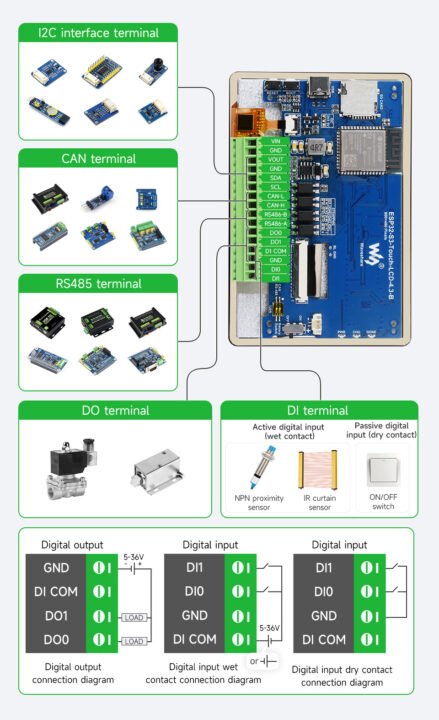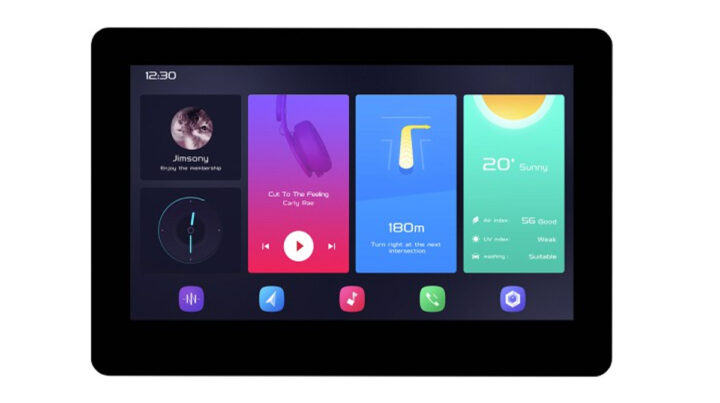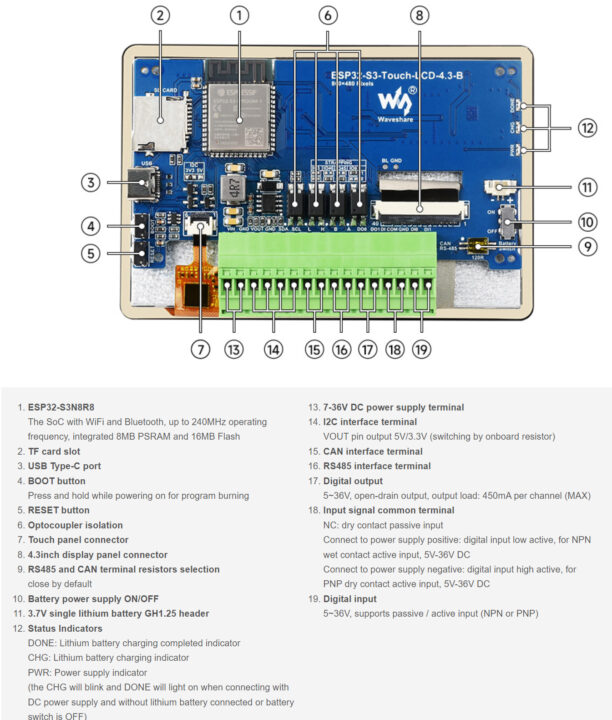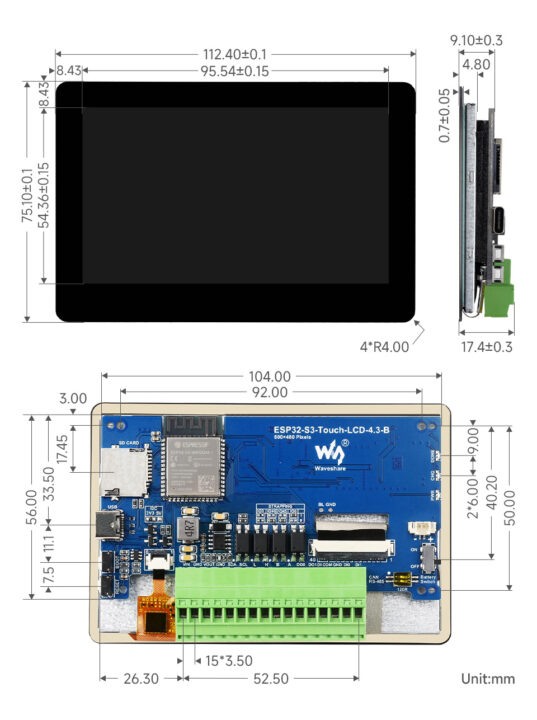Waveshare “ESP32-S3-Touch-LCD-4.3B” is a capacitive touch display development board built around an ESP32-S3 SoC with RS485, CAN Bus, I2C, and isolated DIO interfaces provided through a terminal block. The devkit features a 4.3-inch capacitive touch display that has an 800×480 resolution, RTC, and a microSD card slot. Combined with a wide input voltage range of 7-36V DC, the ESP32-S3-Touch-LCD-4.3V is suitable for IoT HMI, smart home automation, and more.
Previously we have written about similar development boards from Waveshare like the ESP32-S3 1.69-inch touch display, the $15 Waveshare 1.69-inch IPS touch LCD module, the Waveshare RP2040-LCD-0.99-B rounded display but they would offer no expansion pins or GPIO through pads or 4-pin connectors, while the ESP32-S3 display features a terminal block with additional interfaces like RS485 pr CAN Bus that should make wiring more convenient and versatile for the target applications.
Waveshare ESP32-S3 touch LCD specifications:
- Wireless MCU – Espressif Systems ESP32-S3R8
- CPU – Dual-core Tensilica LX7 @ up to 240 MHz with vector instructions for AI acceleration, 384KB ROM.
- Memory – 512KB RAM, 8MB PSRAM
- Storage – 16MB Flash
- Connectivity – 2.4 GHz WiFi 4 and Bluetooth 5.0 LE with support for long-range, up to 2Mbps data rate, mesh network.
- Storage – MicroSD card socket
- Display – 4.3-inch IPS display with 800×480 resolution, 5-point capacitive touchscreen; viewing angle: 160°
- I/O via terminal block
- CAN Bus (TJA1051T/3)
- RS485 (SP3485EN)
- I2C
- Digital Input: 2x DI (5-36V, passive/active, bi-directional optocoupler)
- Digital Output: 2x DO (5-36V, 450mA/channel)
- Additional Features
- Onboard RTC chip
- LED indicators for power and battery status
- Power Supply
- 7-36V DC via terminal block
- USB Type-C
- Rechargeable battery support (3.7V lithium)
- Operating Temperature – 0°C ~ 65°C
- Dimensions – 112.4mm x 75.1mm
The board includes isolated digital outputs, which provide up to 450mA per channel, which in practical cases reduces signal interference. It also has a rechargeable battery and an RTC chip to maintain time data during power interruptions.

The Wiki page provides C/C++ demo code for the Arduino IDE and the ESP-IDF framework plus additional information about the hardware. As we are all aware an ESP32-S3 is also compatible with CircuitPython and MicroPython, but you’d have to work on the code yourself.
The Waveshare ESP32-S3 touch LCD can be purchased from AliExpress for $44.23. The dev board is also available on Amazon for $42.99, and on the Waveshare store for $36.99, but the price for the latter does not include shipping.
Debashis Das is a technical content writer and embedded engineer with over five years of experience in the industry. With expertise in Embedded C, PCB Design, and SEO optimization, he effectively blends difficult technical topics with clear communication
Support CNX Software! Donate via cryptocurrencies, become a Patron on Patreon, or purchase goods on Amazon or Aliexpress








Too bad they are about $10 more than I can justify blowing on a toy I have no practical need for at the moment. 🙁
Don’t get me wrong I think they are definitely worth the asking price and if I had a practical application I’d snap a couple up.
if i were you ,I’d snap a couple up,hh
I am hopping openHASP picks up this board. Have a S3 model that does and it’s the best use case scenario for them even though I hate json. It can be a bit laggy sometimes on sliders for say, lights in home assistant but the 8MB of PSRAM makes a huge difference over the original ESP32 models
As always, pretty good value for makers. Too bad they are basically useless for mass-production. As a dev-kit, sure, but nothing more.
If I had the time and a personal project, I’d buy a 5″ or 7″ e-paper
What makes it useless for mass production? I guess if one would design an enclosure and write software for it, it could end up in a commercial product. Or is it a quality/reliability issue?
A few concerns one might have for mass production:
– Certification (CE, UL, FCC etc). I
see no filtering on power inputs/outputs whatsoever. And with several switching converters and fast microcontroller there is no chance of passing any mandatory certification.
Afaik, Espressif also hasn’t certified their wireless modules.
– Product lifecycle:
you go through the lengthy effort to design a product (with power supply filtering) and Waveshare abandons the product or makes a change. Dang it, now you have to redesign and do your compliance testing all over again. There is no lifecycle indication, let alone a guarantee.
I’m very much a newbie to IC boards, but when I read ‘CAN bus’, I think about automotive diagnostics and performance, possible integration with a car’s OBD2 port, especially with that big bright screen – great for displaying realtime data …
Can this be integrated in with the OBD2 port or take outputs from something that DOES handle car health output but this board can maybe combine those results on the display?